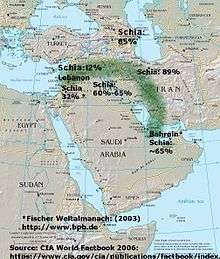Shia Crescent

The Shia Crescent (or Shiite Crescent) is the notionally crescent-shaped region of the Middle East where the majority population is Shia or where there is a strong Shia minority in the population. The corresponding term is especially common in German, where it is known as Schiitischer Halbmond ("Shia Halfmoon").[1]
If it was a Shia-led Iraq that had a special relationship with Iran, and you look at that relationship with Syria and with Hezbollah-Lebanon, then we have this new crescent that appears that would be very destabilising for the Gulf countries and actually for the whole region.
The term was coined in 2004 by King Abdullah II of Jordan at a time when Iran was reportedly interfering in Iraq in the run-up to the January 2005 parliamentary elections.[2] This was in the context of a threatened, later realised, boycott of the elections by Sunnis in Iraq potentially leading to a Shia-dominated government and the assumption that a Shia Iraq might fall under the influence of Shia Iran. The suggestion was that the common religion gives good potential for cooperation between Iran, Iraq, Alawite-dominated Syria and the politically powerful Shia militia Hezbollah in Lebanon; as well, the suggestion was that these others would be proxies for Iran in a regional power play.[3]
The term has developed since to encompass other Shia areas of the Middle East. The nations where Shia Muslims form a dominant majority are Iran and Iraq. Shias also represent a large majority in Azerbaijan, however it is constitutionally a secular state.[4] Those who are actual practicing adherents are much lower,[5] which has led to them generally being excluded from the crescent.[6] Shia are also the majority of citizens in Bahrain, however the government is largely Sunni.[6]
Large Shia minorities also exist in Lebanon, Kuwait, Yemen, Saudi Arabia, Turkey, Afghanistan, Pakistan, India and to a lesser extent, UAE. Excepting Lebanon, where the weak central government structure of Lebanon has allowed Hezbollah to become involved in the Syrian civil war,[7] these are not usually described as part of the crescent.
In 29th International Islamic Unity Conference in Tehran on December 27, 2015, Iranian President Hassan Rouhani called on Muslim countries to unite and strive to improve Islam’s public image, adding that "There is neither a Shiite nor a Sunni crescent. We have an Islamic moon. We, Muslims, are in a world where we must be united".[8]
In January 2016, a confidant of Saudi Prince Mohammad bin Salman Al Saud claimed that the Arab world was confronted "by a Shia full moon”, rather than just a Shia Crescent, as a result of the expanded activities of Iranian-backed Shia militias in countries such as Iraq, Syria and Yemen.[9]
See also
- Axis of Resistance
- Shia–Sunni relations
- Shia Islam: Demographics (For current estimates of Shia proportion of population)
References
- ↑ "Die Hisbollah in der arabischen Misstrauensfalle". Deutsche Welle (in German). 23 July 2006.
- 1 2 Hardball with Chris Matthews:King Abdullah II of Jordan. NBC News. 7 December 2008. Event occurs at 02:06.
- ↑ "Iraq, Jordan See Threat To Election From Iran". The Washington Post. 8 December 2004.
- ↑ "Religion" (PDF). Administrative Department of the President of the Republic of Azerbaijan. 1992. p. 2.
- ↑ "Azerbaijan". CIA Factbook.
- 1 2 "Emerging Shia "Crescent" of Power in the Core of the Middle East". Gulf/2000 Project. 2009.
- ↑ "Analysis - Hezbollah's Syria victory risks wider Sunni-Shi'ite conflict". Reuters. 6 June 2013.
- ↑ http://www.euronews.com/2015/12/27/iran-s-rouhani-urges-muslim-countries-to-unite/
- ↑ "Muhammad bin Salman gambles on intervention abroad and radical economic change at home. But forget about democracy". The Economist. 9 January 2016. Retrieved 14 January 2016.
External links
- The Myth of the Shia Crescent, Project Syndicate (May 2008)
- When the Shia Rise, Foreign Affairs (July/August 2006)
- Shia Crescent on Facebook, (Research from Shia point of view 2014)